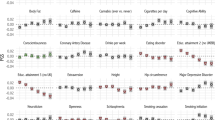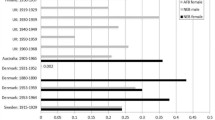Summary
All available evidence indicates that the human mutation rate increases with paternal age. In developed countries, a reduction in the proportion of older parents is a common feature of the marked changes in parental age distribution that occur as a result of family planning. We have related the current paternal age distribution in the European countries for which data is readily available, to a derived curve for paternal agespecific relative mutation rate. The results indicate that, to the extent that it is dependent on paternal age, the mutation rate has decreased considerably in developed countries during the past 50 years. The human mutation rate is a dynamic entity, continuously changing in response to social conditions.
Similar content being viewed by others
References
Blank CE (1960) Apert's syndrome (a type of acrocephalosyndactyly) —observations on a British series of 39 cases. Ann Hum Genet 24:151–164
Carothers AD, McAllion SJ, Paterson CR (1986) Risk of dominant mutation in older fathers: evidence from osteogenesis imperfecta. J Med Genet 23:227–230
Clarke RH, Southwood TRE (1989) Risks from ionising radiation. Nature 339:197–198
Crow JF, Denniston C (1985) Mutation in human populations. Adv Hum Genet 14:59–123
Czeizel A (1989) Hungarian surveillance of germinal mutations: lack of detectable increase in indicator conditions caused by germinal mutations following the Chernobyl accident. Hum Genet 82:359–366
Czeizel A, Kis-Varga A (1987) Mutation surveillance of sentinel anomalies in Hungary, 1980–1984. Mutat Res 186:73–79
Hayes A, Costa T, Scriver C, Childs B (1985) The effect of Mendelian disease on human health II: response to treatment. Am J Med Genet 21:243–255
ICPEMC (1987) Cigarette smoking — does it carry a genetic risk? (International commission for protection against environmental mutagens and carcinogens, publication no 3) Mutat Res 65:71–81
Kondrashov AS (1988) Deleterious mutations and the evolution of sexual reproduction. Nature 336:435–440
Memorandum from a WHO meeting (1986) Prevention of avoidable mutational disease. Bull WHO 64:205–216
Modell B, Kuliev AM (1989) Impact of public health on human genetics. Clin Genet 36:286–298
Modell B, Kuliev AK, Wagner M (1990) Community Genetics Services in Europe. (Public Health in Europe Series) WHO Regional Office for Europe, Copenhagen
Muller HJ (1950) Our load of mutations. Am J Hum Genet 2:111–176
Murdoch JL, Walker BA, Hall JG, Abbey H, Smith KK, McKusick VA (1970) Achondroplasia ⊕- genetic and statistical survey. Ann Hum Genet 33:227–244
Stevenson AC (1957) Achondroplasia: an account of the condition in Northern Ireland. Ann Hum Genet 9:81–91
Tunte W, Becker PE, Knorre G v (1967) Zur Genetik der Myositis ossificans progressive. Humangenetik 4:320–351
United Nations Demographic Yearbook, Special Topic, Natality Statistics (Editions for the years 1949–1950,1954,1959, 1965, 1969, 1975, 1981) Publishing Division, United Nations, New York
Vogel F, Motulsky AG (1986) Human genetics: problems and approaches, 2nd edn. Springer, Berlin Heidelberg New York
Vogel F, Rathenberg R (1975) Spontaneous mutation in man. Adv Hum Genet 5:221–318
Winter RM, Pembrey ME (1982) Does unequal crossing-over contribute to the mutation rate in Duchenne muscular dystrophy? Am J Med Genet 12:437–441
World Health Statistics Annual (1986) Smoking — worldwide trends and their implications, pp 16–19
Author information
Authors and Affiliations
Rights and permissions
About this article
Cite this article
Modell, B., Kuliev, A. Changing paternal age distribution and the human mutation rate in Europe. Hum Genet 86, 198–202 (1990). https://doi.org/10.1007/BF00197705
Received:
Revised:
Issue Date:
DOI: https://doi.org/10.1007/BF00197705




